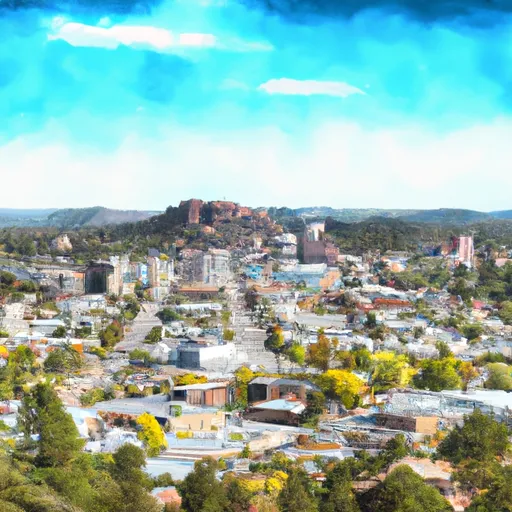-
 Snoflo Premium
Snoflo Premium
Get unlimited access to all our content
With no Ad interruptions! - Start Your Free Trial Login with existing account
Prescott
Eden Index
Climate
9.2
•
Recreation
5.9
•
Community
2.7
•
Safeguard
6.4/10

Prescott, Arizona is a picturesque city located in the central part of the state. Known for its mild climate and breathtaking natural beauty, it offers a unique blend of outdoor recreation opportunities. The city experiences a temperate Mediterranean climate, characterized by four distinct seasons. Summers are warm and dry with average temperatures reaching the mid-80s°F, while winters are cool with occasional snowfall and average temperatures in the mid-40s°F.
Prescott is surrounded by diverse hydrology constituents, including several lakes, creeks, and the nearby Granite Dells. Watson Lake and Lynx Lake are popular destinations for fishing, boating, and hiking, while Granite Creek offers opportunities for kayaking and picnicking. The city is also home to the iconic Thumb Butte, a natural landmark that provides stunning panoramic views and numerous hiking trails.
Outdoor enthusiasts can explore the Prescott National Forest, which offers endless recreational activities such as camping, hiking, mountain biking, and horseback riding. Prescott is also known for its world-class golf courses and renowned rock climbing spots like the Granite Mountain and the Granite Dells. With its favorable climate, rich hydrology constituents, and diverse outdoor recreation opportunities, Prescott is a paradise for nature lovers and adventure seekers.
What is the Eden Index?
The Snoflo Eden Index serves as a comprehensive rating system for regions, evaluating their desirability through a holistic assessment of climate health, outdoor recreation opportunities, and natural disaster risk, acknowledging the profound impact of these factors on livability and well-being.
Climate Health Indicator (CHI): 9.2
Prescott receives approximately
383mm of rain per year,
with humidity levels near 64%
and air temperatures averaging around
13°C.
Prescott has a plant hardyness factor of
7, meaning
plants and agriculture in this region tend to thrive during the non-winter months.
By considering the ideal temperature range, reliable water supplies, clean air, and stable seasonal rain or snowpacks, the Climate Health Indicator (CHI) underscores the significance of a healthy climate as the foundation for quality living.
A healthy climate is paramount for ensuring a high quality of life and livability in a region, fostering both physical well-being and environmental harmony. This can be characterized by ideal temperatures, reliable access to water supplies, clean air, and consistent seasonal rain or snowpacks.
Weather Forecast
Streamflow Conditions
Verde
Area Rivers
Verde
Snowpack Depths
Verde
Reservoir Storage Capacity
Verde
Groundwater Levels
Recreational Opportunity Index (ROI): 5.9
The Recreational Opportunity Index (ROI) recognizes the value of outdoor recreational options, such as parks, hiking trails, camping sites, and fishing spots, while acknowledging that climate plays a pivotal role in ensuring the comfort and consistency of these experiences.
Access to outdoor recreational opportunities, encompassing activities such as parks, hiking, camping, and fishing, is crucial for overall well-being, and the climate plays a pivotal role in enabling and enhancing these experiences, ensuring that individuals can engage in nature-based activities comfortably and consistently.
Camping Areas
| Campground | Campsites | Reservations | Toilets | Showers | Elevation |
|---|---|---|---|---|---|
| Kentuck Springs | 15 | 6,016 ft | |||
| Watson Lake Park | None | 5,199 ft | |||
| Yavapai | 21 | 5,641 ft | |||
| Alto Pit | 10 | 6,084 ft | |||
| Lynx Lake | 36 | 5,632 ft | |||
| White Spar | 59 | 5,639 ft | |||
| Hazlett Hollow | 15 | 5,947 ft | |||
| Lower Wolf Creek | 20 | 6,009 ft |
Nearby Ski Areas
Catastrophe Safeguard Index (CSI):
The Catastrophe Safeguard Index (CSI) recognizes that natural disaster risk, encompassing floods, fires, hurricanes, and tornadoes, can drastically affect safety and the overall appeal of an area.
The level of natural disaster risk in a region significantly affects safety and the overall livability, with climate change amplifying these risks by potentially increasing the frequency and intensity of events like floods, fires, hurricanes, and tornadoes, thereby posing substantial challenges to community resilience and well-being.
Community Resilience Indicator (CRI): 2.7
The Community Resilience Indicator (CRI) recognizes that education, healthcare, and socioeconomics are crucial to the well-being of a region. The CRI acknowledges the profound impact of these elements on residents' overall quality of life. By evaluating educational resources, healthcare accessibility, and economic inclusivity, the index captures the essential aspects that contribute to a thriving community, fostering resident satisfaction, equity, and social cohesion.

